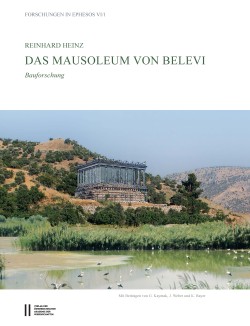


Das frühhellenistische Mausoleum von Belevi liegt 14 km nordöstlich von Ephesos. Über einem massiven quadratischen Sockelgeschoss mit monumentalen Ausmaßen thront eine korinthische Peristasis. Nach der Vorlage einer Monographie aus dem Jahr 1979, bei der wesentliche Teile der Rekonstruktion als noch nicht geklärt betrachtet werden mussten, ermöglichte nunmehr ein Forschungsprojekt der Österreichischen Akademie der Wissenschaften mit Unterstützung des Österreichischen Archäologischen Instituts eine präzise Neuaufnahme und gesicherte Rekonstruktion des Monuments. Im Sockelgeschoss ließen sich dessen Höhe und sein raffinierter Schichtaufbau, die Gestaltung der ionischen Scheintür und der Aufbau der Grabkammer klären. Zweifelsfrei belegen ließ sich die Anlage des Obergeschosses mit einer Peristasis und einem Dach, das nach innen zum offenen, ungenutzten Hof hin entwässerte. Bemerkenswert ist die außergewöhnliche Blendarchitektur vor der Nordwand.
Ein bedeutender Teil der Arbeit ist der Bautechnik gewidmet. Neuerungen wie der intensive Einsatz von Gussmörtel und die Verfeinerung von Versatz- und Verdübelungstechniken kamen zur Anwendung. Der modular durchkomponierte Entwurf des Monuments folgte einfachen und klaren Proportionen. Zahlreiche optische Verfeinerungen bereicherten die Gestaltung. Die von Lykien und Karien übernommene Grundform des Mausoleumtyps wurde mit lokalen, orientalischen, makedonischen und mutterländischen Elementen bereichert, mit Neuerungen versehen und zu einem eigenständigen Ganzen geformt.
Der Projektteil Bauforschung wurde großteils durch den Fonds zur Förderung der wissenschaftlichen Forschung finanziert und mit seiner Unterstützung gedruckt.

…
The early Hellenistic Mausoleum of Belevi is located 14 km northeast of Ephesos. The square structure reached monumental proportions, it consists of a massive lower level, which is crowned with a Corinthian peristasis. Important parts of its reconstruction could not be cleared up in the monographic publication of 1979, so a research project of the Austrian Academy of Sciences supported by the Austrian Archaeological Institute allowed for precise building measurement and the secure reconstruction of the monument. The height of the lower storey, the sophisticated layout of its masonry courses, the design of the Ionic false door and the construction of the grave chamber could be clarified. The layout of the upper floor containing a peristasis with a roof inclining to the inner unused courtyard could be proved. The extraordinary blind façade on the north side is a remarkable feature.
A considerable part of the publication deals with construction techniques. New methods were applied, such as the intensive utilisation of grout mortar and the refinement of block-setting and dowelling techniques. The modularly constructed monument was designed with simple and pure proportions. Numerous optical refinements were included in the design. The basic layout of the mausoleum type deriving from Lycia and Caria was fused together with local, oriental, Macedonian and mainland Greek elements, and provided with innovations to create a new design.
Financial support for the monument’s historical building research was provided in large part by the Austrian Sciences Fund (FWF). Printed with the support of the Fund.
2017,
978-3-7001-7528-5
978-3-7001-8145-3